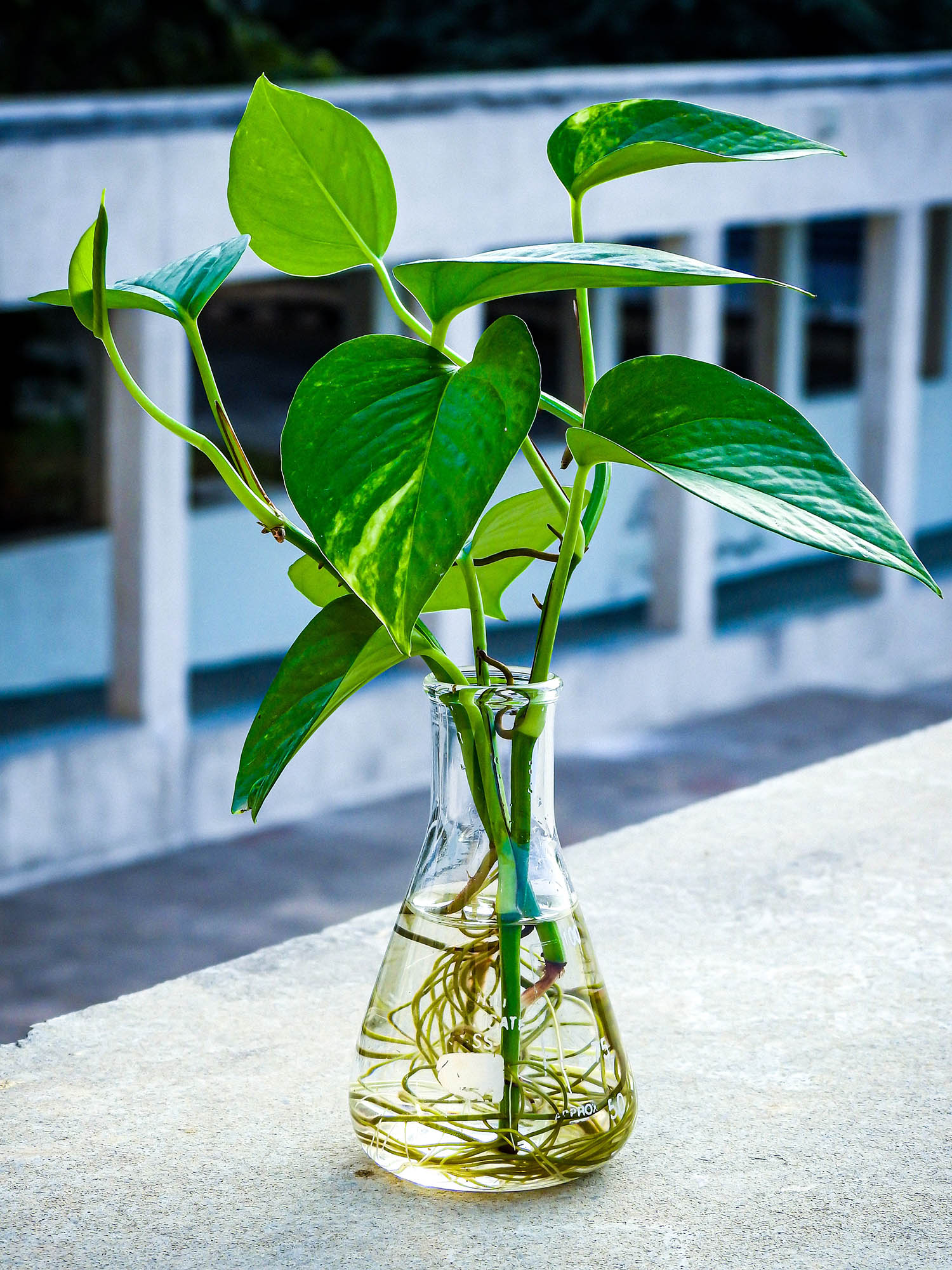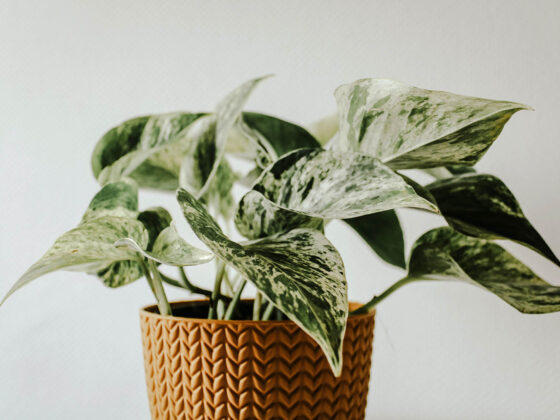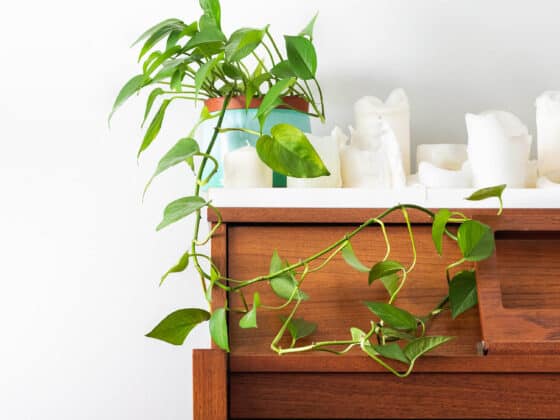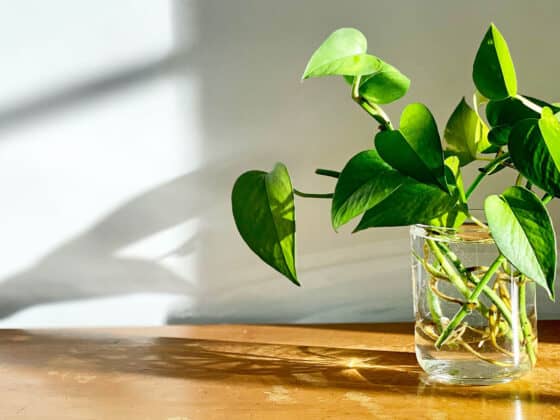You may have heard that propagating a Pothos is easy, but you’ve never tried it for yourself. How can you make sure this process goes off without a hitch? To make it simpler, we’ve prepared a comprehensive guide on slicing, replanting, and growing a section of your plant. This article should answer all your questions about how to propagate a Pothos from cuttings.
A Pothos cutting must include at least one node, and it’s best if it also has a few leaves. You can bury the cutting in soil or place it in a jar of water to grow roots. Either way, make sure the node is below the surface! Use disinfected clippers and a potting mix with good drainage.
We’ll expand on those tips in the article below. And we’ll discuss some common questions and misconceptions about the best ways to clone your plant. By the end, you’ll know everything necessary to turn one Pothos into two or many more.
Can You Propagate a Pothos From a Leaf?
We’re opening with this question because it gets at the core of what it takes to propagate a Pothos from cuttings. Unlike succulents, the Epipremnum (or Pothos) can’t grow back from a leaf alone. You need to include a node.
What is a node? It’s the part of the vine that can contains the tissue necessary to push out new roots and stems. They appear at regular intervals along the stem of a Pothos. You can’t propagate your plant without them.
Spotting a node isn’t too hard. They bulge out from the stem a bit, adding knobbly “joints” to your Pothos vines. They may even be pushing out some roots already. Epipremnum plants can grow aerial roots that help them cling to trees and absorb moisture from the air. These are also known as adventitious roots. A node with aerial roots is a great candidate for propagation since it already has a head start!

Sometimes you’ll see people refer to “root nodes” or “leaf nodes”, but don’t let that confuse you. Any node can produce any other part of the plant – roots, leaves, or more stems. The outcome depends on environmental factors and what your Pothos needs.
Can You Propagate a Pothos Cutting Without Leaves?
So if the nodes are the critical parts, does that mean you can propagate a Pothos from cuttings with no leaves at all? Yes – as long as it has at least one node, any cutting can take root and grow.
However, just because you can do this doesn’t necessarily mean you should. Your Pothos will take longer to get big if it has to grow brand-new leaves before it can start photosynthesizing. It’s usually best to take a stem cutting that includes a couple of leaves. That lets your new plant hit the ground running and start absorbing energy right away.
The one exception is if you need to produce as many babies as you can from one Pothos. If you’re selling them, for example, it might make sense to get the biggest yield possible. In that case, your incentive will be to chop up your Pothos vines into lots of small cuttings, some of which may only have one or two nodes.
How to Take a Pothos Cutting for Propagation
The best tool for taking cuttings is a sturdy set of pruning shears, though scissors should work just fine for a slender vine like a Pothos. It’s also important to have some disinfectant at the ready. You don’t want to introduce bacteria to the cut when you slice into your Pothos.
Good disinfectant options include bleach (1 part mixed into 9 parts water), rubbing alcohol, and hydrogen peroxide. Apply one to a clean rag and wipe down the blades of your cutting tool before you snip.
When choosing your section of stem, keep our advice about nodes in mind. It’s easier to propagate a Pothos from cuttings with more than one node. It’s best if you can plant two or three nodes and still have a couple of leaves poking out aboveground.
Try to clip through in one clean motion. This advice has less to do with the cutting and more to do with the parent Pothos. A jagged, messy cut is more likely to get infected. Keep slicing until you’ve taken all the Pothos cuttings you want to plant.
Should You Let Cuts Callus Over?
Some guides advise you to pop your Pothos cuttings right into the water or soil. Others claim that it’s best to let them callus – leaving them out until the cut end dries out. Letting cuttings callus is a common practice in succulent propagation. The idea is that if the wound seals up, it will be harder for fungi and bacteria to get inside.
There’s a lot of disagreement about whether you should do this when you propagate a Pothos from cuttings. However, even most of the “pro-callus” people agree that you should only wait a few hours. Pothos plants are much less drought-resistant than succulents. If you leave your cuttings for too long, they’ll wilt and maybe die.
Our advice: if you can’t transplant your Pothos pieces within a few hours of cutting them, keep them moist. Bunch some damp paper towels or sphagnum moss around the lower nodes, then wrap them in plastic. This should help the cuttings stay viable for a bit longer, and may even trigger root growth.
Soil or Water – What’s the Best Way to Propagate a Pothos From Cuttings?
There are two main schools of thought on propagating cuttings. One option is to plant them directly into the soil. The other is to let them grow some roots in a jar or glass of water first, then transfer them to a pot.
Lots of people opt for the second option, where they let their plants root in water first. But why would you add the intermediate step? There are a few advantages:
- You don’t have to water the cutting much. Just keep the water level above the nodes.
- There’s no need to worry about root rot. The fungi and bacteria that cause this condition live in wet soil, but not water alone.
- The humidity around your cutting’s leaves will be high due to evaporation, which your Pothos will like.
- It’s fun to watch the roots grow in water.
The main argument against water propagation is that it’s unnecessary. As long as you’re careful not to overwater or underwater your cuttings, they’ll do just as well in soil. And if you root your Pothos in water and then transplant it into potting mix, you’re setting back its progress, because it will have to replace the water roots with soil roots. This process is traumatic, and not all cuttings survive it.
In our view, water propagation is a great option if a piece of the stem breaks off and you don’t have any soil on hand. You might also choose to keep your Pothos in water for the long haul – they’re great candidates for low-effort hydroponics.
But in general, we recommend propagating Pothos cuttings directly in potting mix if you can. Rooting in water adds an unnecessary transitional phase that will stress your Pothos out and delay its growth. The drawbacks are minor, though, so don’t sweat it too much.
Preparing Soil to Propagate a Pothos From Cuttings
Let’s say you’ve decided against water propagation for your Pothos cuttings What kind of soil will work best? Actually, if you want to get technical, the answer is no soil at all.
We know, it’s confusing. “Soil” can be a generic term for any potted plant’s growing medium. But it can also specifically mean the stuff you’d find if you stuck a shovel into your garden. Don’t use any of that second kind of “soil” when you propagate a Pothos from cuttings. It’s way too fine and dense. In the close quarters of a pot, it will get waterlogged and smother the roots.
Instead, use a soilless potting mix with good drainage and aeration. One good guideline: make sure that just over half of the ingredients are large chunks that won’t break down quickly. These can include:
- Conifer bark, the kind often sold as an orchid potting medium
- Coarse perlite – #3 grade is good
- Horticultural charcoal
- Pumice
- Very coarse sand, the kind you’d use for a succulent
The remainder should be fluffy, absorbent materials like:
- Coconut coir
- Peat moss
- Compost – especially worm compost
Try this mix (but feel free to tweak it as you develop your own plant care style): 40% perlite, 30% coco coir, 20% orchid bark, and 10% worm compost.
If you want something a bit simpler, you could start with a store-bought African Violet mix. Then mix it with perlite in a 50-50 ratio. Or you could spring for a boutique aroid-friendly potting mix. (Aroids are members of the Araceae plant family, which includes Pothos).
How to Propagate Pothos Cuttings in Soil
Prepare your potting mix ahead of time, as described above. Then get some small pots, one for each cutting you’re going to propagate. Alternatively, you can plant multiple cuttings in the same pot, in which case you’ll naturally need a larger one. Some growers like to do this because it results in a bigger, bushier cluster of Pothos vines. Either way, make sure the pots have holes in the bottom for drainage.
Get the soil a little damp before planting your Pothos cuttings. It should be moist enough that you can roll it into clumps between your fingers. But don’t get it so wet that it’s glistening or sludgy. Fill the pots up and use your finger to poke a hole into the potting mix for each stem chunk. Again, go deep enough that at least one node will be underground.
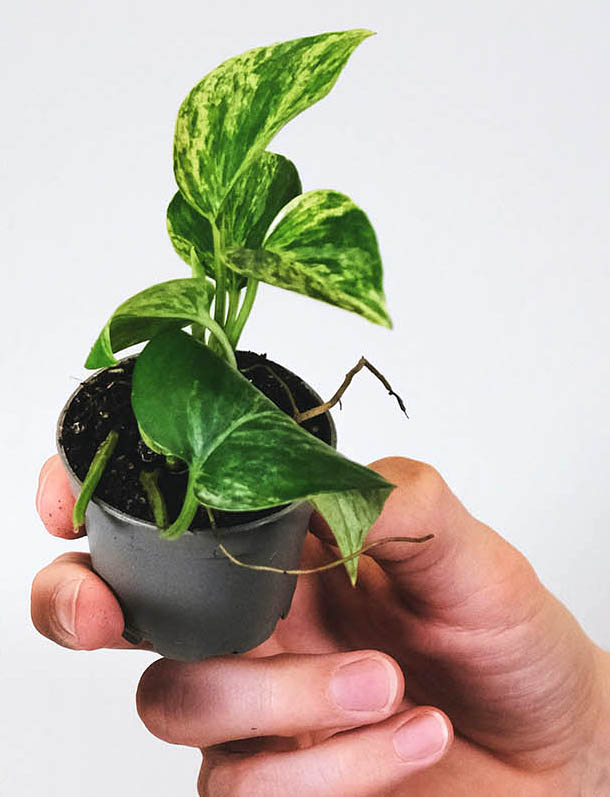
Settle the stem sections into the potting mix. Then do your best to make them comfortable. Important factors include:
- Lighting. Provide lots of bright, indirect light, but no direct sun exposure. Place them 5 or 6 feet away from a well-lit window (or closer, if you hang some sheer curtains).
- Warmth. Maintain temperatures between 68 and 85 degrees Fahrenheit – the steadier, the better.
- Hydration. Water sparingly, only adding more when the top 2 inches of soil feel dry.
- Humidity. Keep the humidity above 60% if possible. A humidifier is a good way to handle this, though popping a clear plastic bag over each cutting works too.
- Soil minerals. Avoid adding any fertilizer. Your cuttings aren’t developed enough to use it yet, and it will only cause stress.
Keep this care routine up for about 4-6 weeks, or until you see your clones producing new foliage. After that, you can care for them like any other Pothos plant!
How to Propagate a Pothos From Cuttings in Water
If you want to try water propagation instead, you don’t need to worry about drainage. Just find a glass, vase, or jar that can hold enough water. Clear glass is usually the way to go, because it lets you keep an eye on the root development.
Use filtered, distilled, or reverse osmosis water if it’s an option. Tap water won’t necessarily be a problem for your Pothos cuttings, but it’s not ideal. Fill the jar up until at least one node is underwater – if you can get 2-4, that’s even better.

The care requirements for Pothos cuttings in water are pretty similar to those we listed above for soil propagation. You don’t need to worry about humidity, though. And, of course, watering isn’t a concern. But you should change out the water in the jar about once per week. If you notice algae forming, dump out the jar and rinse the roots and stem of your Pothos before refilling.
When Is Your Pothos Cutting Ready To Be Planted?
As we noted above, you can grow a Pothos in water for pretty much as long as you want. However, if you’re looking to transplant it into the soil, you shouldn’t wait too long. Water roots are more fragile than soil roots. The longer they grow, the harder it will be for your Pothos to adjust to life on land.
You should move your Pothos cuttings to soil once the roots are an inch or two long. This usually takes around 6-8 weeks, but lots of factors can influence the growth rate. Be patient with your Pothos if it seems to be taking a while to root.
When you’re ready to move the plant to a pot, follow the same advice we gave above for soil propagation. You’ll just need to make the hole in the potting mix a little larger to make room for the roots. Be as gentle with your transplants as you would with fresh cuttings – no direct sunlight, no fertilizer, etc.
Alternative Growing Mediums For Pothos Cuttings
Some growers like to take a middle approach between soil and water. They’ll propagate their cuttings in a uniform, sterile medium. This cuts down on the risk of root rot, while allowing the plant to grow some soil roots. This eases the transition when you move it to soil later on.
(You can also keep your Pothos in this medium permanently. This is called “semi-hydroponic” growing, or “semi-hydro” for short).
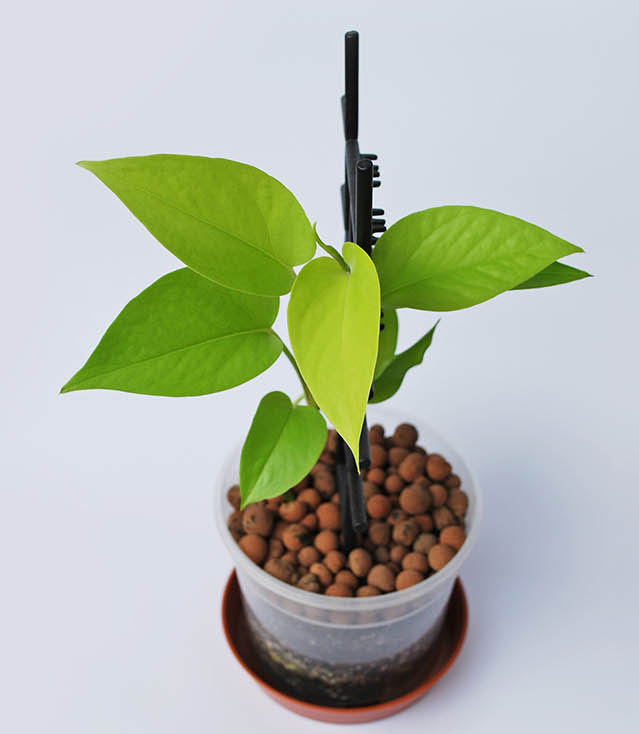
A substrate for rooting Pothos cuttings needs to be loose, lightweight, and capable of wicking moisture up to the roots. Inorganic materials are better, because they’re less likely to decay or harbor fungi. The most common choices are:
- LECA. Lightweight spheres of clay that have been baked to make them porous. They’re pricy, but reusable – you can wash and recycle the same LECA spheres over and over. You can check out our detailed guide on LECA for houseplants if you’re curious.
- Perlite. Heat-treated volcanic glass with similar properties to LECA. It’s usually used as a soil additive, but also works as a standalone medium. It comes in several grades, and the coarser ones will work better here.
- Vermiculite. This is like a slightly finer and denser version of perlite. You’ll have to be a little more careful about overwatering.
- Pumice. Naturally porous volcanic rock. It’s got some aesthetic appeal for those who like the visual of roots growing over jagged rocks. Pumice is usually cheaper than LECA, but also heavier.
Planting Pothos Cuttings in a Rooting Medium
Rinse and moisten your substrate before planting your cuttings. With LECA, you’ll have to let it soak for about 24 hours. In the process, it will swell up to around 5 times its size!
Place the substrate in a tall jar, then add enough water to fill the bottom ¼-⅓. The rooting medium should soak up moisture and transfer it to your Pothos without letting the plant sit in water. Care for your clones just as you would if you were propagating in water. Then plant them in soil once they’ve grown some decent-sized roots.
Other FAQs About Pothos Cuttings
Do You Need to Use Rooting Hormone on Pothos Cuttings?
Adding synthetic hormones when you propagate a Pothos from cuttings is 100% optional. It will generally make your cuttings grow more roots in less time, but it’s not necessary.
Rooting hormone comes in liquid or powdered forms. The powder is usually better for propagating in soil. Simply dust it over the lower nodes before planting your Pothos cutting. Liquid hormone is better for water propagation. You can just add a couple of drops to the jar.
Will Cinnamon Help My Pothos Root?
Despite some common claims, there’s no evidence that cinnamon is a “natural rooting hormone.” It is a mild antifungal agent, so sprinkling a bit over the cut can reduce the risk of root rot. But it won’t do anything to make the roots grow faster.
What Time of Year is Best for Propagating a Pothos From Cuttings?
Your Pothos cuttings will root best if they’re getting a good amount of light, warmth, and humidity. That means that spring and summer tend to work better than fall and winter. You can still succeed at propagation during the colder months, though. You’ll just need to be a little more patient and a lot more careful about overwatering.
Why Is My Pothos Cutting Not Rooting?
If it’s been several months and you’re seeing little to no root growth, your Pothos clones most likely need more sunlight, humidity, or warmth. You might also need to change the water more frequently, which will increase oxygenation.
It’s also possible that the stem section you clipped was weak or sick. Try to take cuttings only from Pothos vines that look strong and vibrant.
Why Are My Pothos Cuttings Wilting or Turning Yellow/Brown?
There are a few possibilities when you see your baby plants wilting and getting discolored. It’s pretty normal for the leaves to droop for a few days after being transplanted. In many cases, all you need to do is wait for your Pothos to get over the shock.
Sudden wilting in a cutting that’s been okay for a while could be due to overwatering (in soil) or lack of oxygen (in water). Try letting the potting mix dry out for at least a few days before watering again. If the problem persists, take your cutting out of the soil and check for root rot. If you’re propagating in water, see our advice above about changing it out more frequently.
Underwatering or sunburn are other possibilities. Make sure your cuttings are getting enough hydration and they’re not sitting in direct sunlight.
Will My Pothos Regrow After I Take a Cutting?
Absolutely! The plant will send out new growth from the last node before the spot where you made your cut. The only exception is if there are no more leaves on the vine – it may not have enough energy to regrow. Trimming a stem close to the soil may encourage new growth from the center of your Pothos.
Final Thoughts
This may seem like a lot of information to absorb, but don’t be intimidated. It’s actually pretty easy to propagate a Pothos from cuttings. We’ve tried to give you everything you need to do the best possible job, but there’s no substitute for jumping in and giving it a try! As long as you’re careful not to overwater, you should be able to produce lots of healthy Pothos clones.






